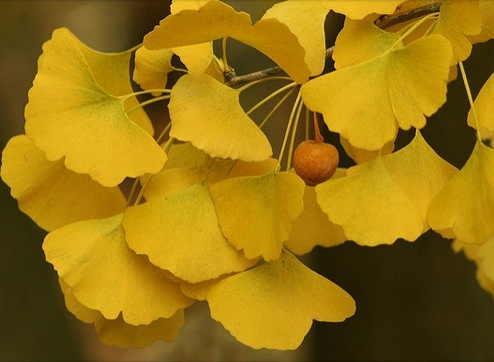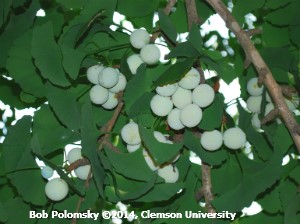Name That Tree
By Gil Medeiros
If you selected Ginkgo biloba, you are correct (give yourself a gold star). The fan-shaped, lobed leaves, 2-3 inches long, are the best identification key.

Yellow Autumn Leaves
It will grow at a moderate rate to 50 to 75 feet tall and spread to about 35 feet.
Our region is in the “Goldilocks zone” for this tree: “Not too hot, not too cold; just right.”
Ginkgo is an all-around athlete in that it can thrive in soils that are acidic, alkaline, compressed, or loose — that’s one reason it succeeds as a street tree. The limbs resist breakage in the wind. It is also a respectable shade tree when mature. You are not likely to outlive this tree; it can live 1,000 years.
There are numerous cultivars available, even a dwarf version that grows to a maximum of 6 feet. This makes a great focal point shrub in the back of a bed. The cultivars offer variations of tree form from columnar to vase-shaped.

Female Ginkgo biloba with fruit
The seeds are edible after the outer fleshy part has been removed and the seeds are roasted. This is a delicacy in Asia.
Ginkgo biloba also refers to an extract of the leaves, which is used to treat a wide range of maladies. There is evidence it is effective in treatment of Alzheimer’s disease, macular degeneration, schizophrenia and others.
References
• Ginkgo, Maidenhair Tree, Virginia Cooperative Extension, 2901-1046
• Ginkgo or Maidenhair Tree, HGIC 1032, Clemson Cooperative Extension
• Ginkgo biloba: Maidenhair Tree, Publication #ENH432, University of Florida, IFAS Extension
• Ginkgo biloba, NC State Extension
• Find a Vitamin or Supplement, GINKGO, WebMD